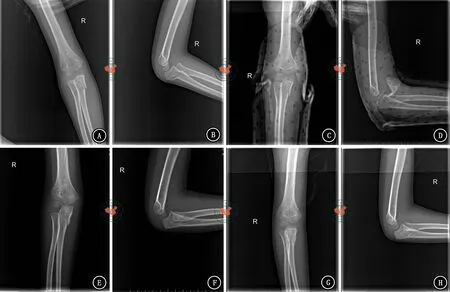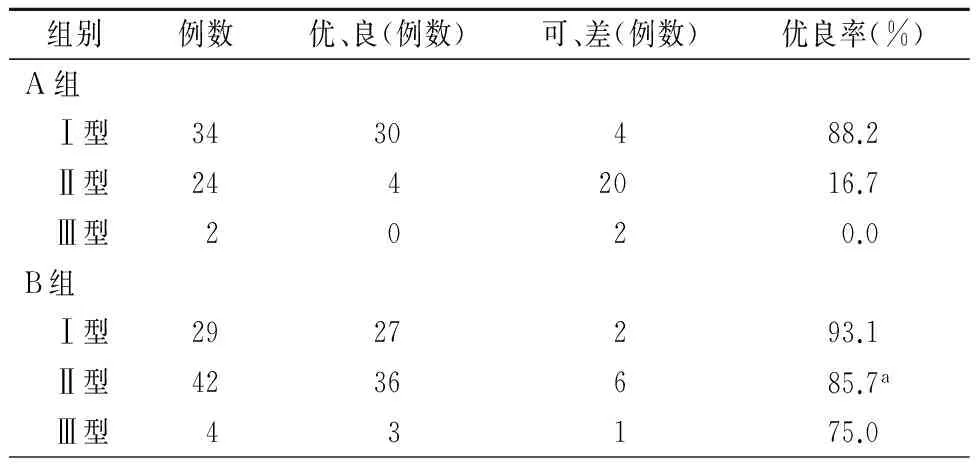孟氏骨折新分型及其指导临床治疗的疗效观察
连鸿凯 黄金承 张景义 白玉 程富礼 宋相建 景小博
小儿骨科(张景义、白玉、程富礼、宋相建、景小博)
通讯作者:黄金承,Email:drlaohuang@163.com
【摘要】目的探讨及评价新鲜儿童孟氏骨折新分型指导临床治疗的疗效。方法采用前瞻性研究方法,对2007年1月至2012年12月收治的125例新鲜儿童孟氏骨折患者,采用孟氏骨折新分型标准进行分型,各分型内患者按门诊号或住院号的单双进行分组:单号为A组,患者先接受闭合手法复位进行治疗,若闭合手法复位失败则转为手术治疗;双号为B组,患者均接受手术治疗。其中,属于新分型中Ⅰ型的患者共66例,接受闭合手法复位治疗的共37例(ⅠA组),接受手术治疗的共31例(ⅠB组,包括ⅠA组中2例闭合手法复位失败者);属于新分型中Ⅱ型的患者共55例,接受闭合手法复位治疗的共26例(ⅡA组),接受手术治疗的共44例(ⅡB组,包括ⅡA组中15例闭合手法复位失败者);属于新分型中Ⅲ型的患者共4例,接受闭合手法复位治疗的共2例(ⅢA组),接受手术治疗的共4例(ⅢB组,包括ⅢA组中2例闭合手法复位失败者)。按HSS肘关节功能评分标准对各组患者治疗6个月后肘关节功能的优良率进行统计分析。对于闭合手法复位失败的患者,肘关节功能优良率视为差。结果125例患者中,9例患者失去随访,116例患者获得随访(随访率92.8%),随访时间9~31个月(平均18.9个月),其中属于新分型Ⅰ型的共61例,新分型Ⅱ型的共51例,新分型Ⅲ型的共4例;接受闭合手法整复的共60例,接受手术治疗的共75例(包括闭合手法复位失败的19例)。12例合并桡神经损伤的患者,在桡骨头复位后8~12周均开始恢复。ⅠA组中优28例,良2例,可2例,差2例,优良率88.2%;ⅠB组中优25例,良2例,可2例,差0例,优良率93.1%;两组患者优良率比较,差异无统计学意义(P=0.822)。ⅡA组中优1例,良3例,可5例,差15例,优良率16.7%;ⅡB组中优34例,良2例,可6例,差0例,优良率85.7%;两组患者优良率比较,差异有统计学意义(P=0.000)。ⅢA组中优0例,良0例,可0例,差2例,优良率0.0%;ⅢB组中优2例,良1例,可1例,差0例,优良率75.0%;两组患者优良率比较,差异无统计学意义(P=0.400)。结论以上尺桡关节分离程度为分型依据的新鲜儿童孟氏骨折新分型对指导临床治疗方式的选择有较好的效果,其中属于新分型Ⅰ型者应首选闭合手法复位治疗,属于新分型Ⅱ型及Ⅲ型者,应首选手术治疗。
【关键词】 孟氏骨折; 上尺桡关节分离; 新分型; 临床疗效
【Abstract】BackgroundIt is widely accepted that the closed reduction should be performed in priority in the choices of treatment for the fresh Monteggia fractures of the children. If the closed reduction failed, surgical intervention should be chosen. However, although most of the patients with the closed reduction can reach satisfactory outcomes, it is possible that the reduction may be failed and exacerbate the psychic trauma of the patients and their parents. Moreover, excessive repeated closed reduction could also make more disruption of local soft tissue around the elbow joint. Based on many years clinical observation, we introduced a new clinical classification for fresh Monteggia fracture of children, including three types:type 1 ulnar fracture with mild separation of the upper radioulnar joint and subdislocation of the humeroradial joint, type 2 ulnar fracture with severe separation of the upper radioulnar joint and complete dislocation of the humeroradial joint, and type 3 fractures of both ulnar and radius with dislocation of the radial head. We recommend closed reduction for the type Ⅰ injury, and surgical intervention for type 2 and 3 fractures.MethodsIn the present study,125 patients with acute Monteggia fractures from Jan 2007 to Dec 2012 were discussed according to the classification mentioned above. During this follow-up,9 patients were lost to follow up,116 patients were successfully followed for 9 to 31 months (mean,18.9 months). The rate of follow-up was 92.8%. In this 116 patients,49 were left elbow injuries, and 67 were right elbow injuries.Twenty patients were associated with the radial nerve injury. Their ages ranged from 1 to 14 years (mean, 4.7 years). Time since injury ranged from 1 hour to 26 hours (mean,4.2 hours).(1)Inclusion criteria:①Patients suffered from Monteggia fractures according to the new classification, aged less than 18 years;②Time since injury <3 weeks;③Fresh fracture, not treated by other hospital.(2)Exclusion criteria:①open fracture;②complicated by acute compartment syndrome which need emergency intervention;③any disease history threatening life, such as malignant tumors;④severe mental disease or disability to live himself in daily life;⑤poor in compliance or deny to participate in the trial program;⑥participated in other trial program in 1 month before the follow-up;⑦any conditions that researcher considered would influence the effectiveness or safety of the trial.All fractures were classified according to the new classification system. Then the patients were randomized into two groups based on their ID number of outpatient or inpatient. Those with odd ID number were allocated to group A, and those with even ID number were distributed into group B. Patients in group A were in the treatment of closed reduction. Operation would be performed if closed reduction failed. Patients in group B were treated by operation. Sixty-six fractures were classified as type Ⅰ. GroupⅠA had 37 patients who received closed manipulation. GroupⅠB were composed of 31 patients who received surgical operation.Fifty-five cases were classified as type Ⅱ,26 cases in group ⅡA, and 44 cases in group ⅡB. The reduction failed in 15 cases from the group ⅡA. Only four cases were classified as type Ⅲ. Two cases originally arranged in group ⅢA failed in the closed treatment, so all the 4 cases of type Ⅲ were in group ⅢB. The clinical outcomes were analyzed during the 6 months after the initial treatment. (3)Treatment Methods:①Closed Reduction Group:The deformity of the ulnar or radius was first corrected, then the dislocation of the radial head was reduced. The patient was placed in supine position, after the brachial plexus block or general anesthesia, the shoulder was abducted with the extended elbow and the supination of the forearm. Two assistants held the distal upper arm and the wrist joint, respectively. The surgeon held the ends of the fracture site, and pressed the ulnar fracture ends in the opposite direction of the angular deformation by lifting and pressing methods, which could make the angular and overlap deformity corrected. Then the surgeon pressed the radial head in the opposite direction of dislocation and reduced the radial head. The reduction was considered as successful if the raidal head did not dislocate again while the elbow was slightly flexed. For patients with both ulnar and radius fractures, the ulnar and radius overlap and angular deformity should be first corrected, and then the dislocation of the radial head was restored. The reduction could be performed twice more following the failure of the first reduction. ②Operation group:This group were treated by open reduction and internal fixation. Boyd incision was made along the posterior-lateral side of the elbow joint with a length of 10 cm. The skin, subcutaneous tissue and fascia were cut, then the ulnar and radius were visible. The fractures were anatomically reduced and fixed with plates. Then the radial head was reduced with the elbow flexed to 90 degrees. A 1.4mm Kirschner wire was inserted into the posterior elbow side along the radius canal to fix the humeroradial joint. The cast was immobilized at the elbow in the flexion of 90 degrees. The Kirschner wire was removed 6 weeks postoperatively and functional exercise began. The plates were removed 3 months postoperatively.③Management of the radial nerve injury:12 patients were combined with radial nerve injury, but were not treated by the nerve exploration. Only drugs were used to restore the nerve function. The symptoms started to recover during the 8 to 12 weeks after the restoration of the radial head.ResultsOne hundred and sixteen patients were followed up. The mean period of the follow-up was 18.9 months (range,9-31 months).Nine cases were lost to follow up. The rate of the follow-up was 92.8%.Sixty one cases from typeⅠ,51 cases from type Ⅱ and 4 cases from type Ⅲ were successfully followed up. The functional outcome was evaluated using the HSS scoring. The outcome would be regarded as bad if closed reduction failed in group A. There were no significant differences both between group ⅠA and ⅠB (P=0.822>0.05), and between group ⅢA and ⅢB (P=0.40>0.05). The difference between group ⅡA and ⅡB was statistically significant (P=0.00<0.05).DiscussionThough multiple classification systems for Monteggia fracture exist in clinical application, the Bado classification is most commonly used, which divides the Monteggia fracture into 4 types according to the direction of radial head dislocation in the imaging examination. For its neglect of the separation of the upper radioulnar joint, the Bado classification can not guide the prime clinical choice. Through the long-term clinical observation, we found that the operation would be needed because the closed reduction frequently failed in those patients with the so-called complete dislocation of the humeroradial joint, which was shown by X-ray that the distance between the radial side of the coronoid process and the medial side of the radial head was larger or equal to the width of the radial head in anteroposterior position of the elbow, or the inferior border of the radial head totally were separated with the superior border of the ulnar in lateral position. Comparatively, the mild separation of the upper radioulnar joint may be generally treated by the closed reduction. Severe separation of the upper radiounlar joint is mostly caused by high energy trauma, which could make the annular ligament totally ruptured and lose its constraint of the radial head. The ruptured annular ligament and the adjacent soft tissue would be entrapped into the joint space, which could impede the restoration of the radial head. Even the closed reduction was successfully performed, the unstable ends of the ulnar fracture site might be easily displaced after the fixation of the splint or cast. However, the patients with the mild separation of the upper radioulnar joint usually suffered the relatively lower energy trauma. In addition, the radial head epiphysis of the children were more fragile compared with their ligaments. Therefore, those radial heads were dislocated from the inferior border of the annular ligament, and the rupture of the annular ligament did not occur in most of those patients. After the correction of the greenstick fracture deformity or displacement, their radial head could always be restored to its position, and good clinical outcomes would be obtained due to their low possibility of redisplacement or redislocation.ConclusionsThe new classification method can facilitate the treatment for the Monteggia fracture. Closed reduction should be the prime choice for the type Ⅰ fracture, and operation would be recommended for the typeⅡ and Ⅲ fractures. It could obtain satisfactory clinical outcomes to choose the appropriate treatment according to the new classification system. Meanwhile, unnecessary iatrogenic injury could be avoided. Considering that the sample size of our study is limited, more observation and investigation need to be further performed.
【Keywords】 Monteggia fracture; Dislocation of the proximal radioulnar joint; New classification; Curative effect
1814年,学者Monteggia首次将尺骨上1/3骨折合并桡骨头向前脱位的病变定义为孟氏骨折。1967年,学者Bado将孟氏骨折的概念进一步完善为:任何部位的尺骨骨折合并桡骨头脱位。随着对孟氏骨折研究的不断深入,现将桡骨头各方向脱位合并不同水平的尺骨骨折或尺、桡骨双骨折都列入孟氏骨折的范畴。在新鲜儿童孟氏骨折治疗方式的选择上,目前公认的思路为先行闭合手法复位治疗,若闭合手法复位失败即转为手术治疗。虽然多数患者经过闭合手法复位治疗能取得不错的临床疗效,但对于闭合手法复位治疗不能成功的患者而言,额外的闭合手法复位不仅增加了患者家属及患者的心理创伤,而且对患者肘关节周围软组织更是一种破坏。
我们根据长期临床观察,以上尺桡关节分离程度为标准提出新鲜儿童孟氏骨折新分型,将新鲜儿童孟氏骨折分为三型:Ⅰ型为尺骨骨折,上尺桡关节轻度分离,肱桡关节部分脱位;Ⅱ型为尺骨骨折,上尺桡关节重度分离,肱桡关节完全脱位;Ⅲ型为尺、桡骨双骨折,合并桡骨头脱位。对于Ⅰ型患者,我们认为应选择闭合手法复位治疗,Ⅱ型及Ⅲ型患者应选择手术治疗。以此为指导思想,我们对郑州市骨科医院2007年1月至2012年12月收治的125例新鲜儿童孟氏骨折患者采用孟氏骨折新分型进行研究,旨在探讨及评价该新分型对指导临床治疗的效果。
资料与方法
一、临床资料
1.诊断标准:以桡骨头各方向脱位合并不同水平的尺骨骨折或尺、桡骨双骨折为标准进行诊断。
2.纳入标准:(1)根据孟氏骨折诊断标准确诊的孟氏骨折患者,男性或女性,年龄<18岁;(2)受伤时间<3周;(3)首诊患者,未在其他医院接受过治疗。
3.排除标准:(1)开放性骨折的患者;(2)有前臂筋膜综合征,需急诊手术治疗的患者;(3)有包括恶性肿瘤在内的任何严重威胁生命疾病史的患者;(4)有严重精神病史或生活不能自理的患者;(5)有对正规治疗依从性差的病史,或不愿意服从试验方案的患者;(6)在随访之前1个月内参与了任何其他临床试验的患者;(7)任何研究者认为将影响有效性或安全性结果的情况。
4.患者一般情况:采用前瞻性研究方法。以2007年1月至2012年12月收治的符合纳入标准的125例新鲜儿童孟氏骨折患者为研究对象。其中,9例患者失去随访,116例患者获得9~31个月的随访(平均18.9个月),随访率为92.8%。左侧损伤49例,右侧损伤67例;合并桡神经损伤者共12例。患者年龄1~14岁(平均年龄4.7岁),受伤时间1~26 h(平均间隔时间4.2 h),随访时间9~31个月(平均18.9个月)。按新鲜儿童孟氏骨折新分型标准进行分型,Ⅰ型61例,Ⅱ型51例,Ⅲ型4例。按门诊号或住院号的单双进行分组,单号先接受闭合手法复位治疗,若闭合手法复位失败则转为手术治疗(A组),双号接受手术治疗(B组)。参加研究的骨科医师共6名,其中3名参与闭合手法复位治疗,3名参与手术治疗。属于新分型中Ⅰ型的患者61例,接受闭合手法复位治疗的共34例(ⅠA组),接受手术治疗的共29例(ⅠB组,包括ⅠA组中2例手法复位失败者);属于新分型中Ⅱ型的患者共51例,接受闭合手法复位治疗的共24例(ⅡA组),接受手术治疗的共42例(ⅡB组,包括ⅡA组中15例闭合手法复位治疗失败者);属于新分型中Ⅲ型的患者共4例,接受闭合手法复位治疗的共2例(ⅢA组),接受手术治疗的共4例(ⅢB组,包括ⅢA组中2例闭合手法复位治疗失败者)。各分组内A、B两组患者年龄、受伤时间、平均随访时间等临床资料比较,差异无统计学意义,具有可比性,见表1。

表1 新鲜儿童孟氏骨折患者一般临床资料
二、治疗方案
1.闭合手法复位组(图1):采用闭合手法复位进行治疗。根据先纠正尺骨或桡骨骨折畸形,再整复桡骨头脱位的原则进行复位[1]。选择臂丛麻醉或全麻,患者仰卧位,肩外展,在肘关节伸直、前臂旋后位体位下,两助手分别紧握患肢上臂下段及患肢手腕部做对抗牵引,术者双手分别握住骨折断端两侧,通过提按手法,用与尺骨骨折断端间成角方向相反的力按压尺骨两断端,纠正尺骨断端间成角及重叠畸形。然后,术者双手拇指用与桡骨头脱位方向相反的力按压桡骨头,使桡骨头复位。复位结束后,轻微屈伸肘,若桡骨头不再脱位,则说明复位成功。对于尺、桡骨双骨折的患者,术者先纠正尺、桡骨重叠、成角、旋转移位,再整复桡骨头脱位。对于一次手法复位失败者,可再行手法复位,但不超过3次。
复位成功后,用石膏托将肘关节固定在屈曲90 °,前臂中立位,于尺骨断端及桡骨头脱位处放置衬垫,以防止骨折移位及桡骨头再脱位,观察末梢血液循环及感觉。第5、14天拍X线片复查,若有移位等情况,及时调整。8例患者在第5天X线片复查时,见尺骨骨折移位,经再次整复后纠正。石膏托固定6~8周,直至骨折脱位临床愈合。
2.手术治疗组(图2):采用切开复位内固定进行治疗。沿肘后外侧Boyd切口,长10 cm,切开皮肤、皮下组织、筋膜,显露尺骨、桡骨,解剖复位尺(桡)骨骨折断端,钢板进行内固定;复位桡骨头,屈肘90 °,取一根直径1.4 mm的克氏针,由肘后进入,沿桡骨髓腔贯穿固定肱桡关节,折弯、剪断钢针,尾部埋于皮下。术后前臂中立位屈肘90 °石膏托固定,术后6周拔出克氏针拆除石膏行肘关节主动功能锻炼,术后3个月拆除钢板。

图1 患儿男性,5岁,右肘外伤6 h,诊断为右孟氏骨折,新分型Ⅰ型,行手法闭合复位治疗。A、B图示治疗前肘关节X线正、侧位图像,显示桡骨头向前侧脱位,上尺桡关节轻度分离,肱桡关节部分脱位;C、D图示闭合手法整复后肘关节X线正、侧位图像,显示尺骨断端复位,桡骨头复位;E、F图示闭合手法整复4周后复查肘关节X线正、侧位图像,显示尺骨断端对位、桡骨头复位尚可;G、H图示手法整复8周后复查肘关节X线正、侧位图像,显示尺骨断端愈合,桡骨头位置尚可

图2 患儿女性,7岁,右肘外伤14 h,诊断为右孟氏骨折,新分型Ⅱ型,先行闭合手法复位石膏外固定治疗,治疗失败后转为手术治疗。A、B图示手法整复前肘关节X线正、侧位图像,显片示桡骨头向前侧脱位,上尺桡关节重度分离,肱桡关节完全脱位;C、D图示手法整复后肘关节X线正、侧位图像,显示尺骨断端复位欠佳,桡骨头仍脱位;E、F图示术后X线正、侧位图像,显示桡骨头复位,肱桡关节行克氏针固定,尺骨截骨行钢板内固定;G、H图示术后3个月取出内固定后X线正、侧位图像,显示尺骨愈合良好,桡骨头复位良好
3.桡神经损伤的处理:本次研究中,共12例患者治疗前存在桡神经损伤症状,我们均未做神经探查术,常规给予促进神经损伤恢复的药物1~2个疗程,在桡骨头复位后的8~12周内,桡神经损伤症状均开始恢复。
三、统计学处理方法

结 果
116例患者获得随访(随访率92.8%),其中属于新分型Ⅰ型的共61例,新分型Ⅱ型的共51例,新分型Ⅲ型的共4例,接受闭合手法整复的有60例,接受手术治疗的有75例(包括闭合手法复位失败的19例)。随访时间9~31个月(平均18.9个月)。12例合并桡神经损伤的患者,在桡骨头复位后8~12周均开始恢复。治疗6个月后,按HSS肘关节功能评分标准[2]对患者肘关节功能的优良率进行评价,闭合手法复位失败者,肘关节功能优良率视为差。ⅠA组中优28例,良2例,可2例,差2例,优良率88.2%;ⅠB组中优25例,良2例,可2例,差0例,优良率93.1%;两组患者优良率比较,差异无统计学意义(P=0.822)。ⅡA组中优1例,良3例,可5例,差15例,优良率16.7%;ⅡB组中优34例,良2例,可6例,差0例,优良率85.7%;两组患者优良率比较,差异有统计学意义(P=0.000)。ⅢA组中优0例,良0例,可0例,差2例,优良率0%;ⅢB组中优2例,良1例,可1例,差0例,优良率75%;两组患者优良率比较,差异无统计学意义(P=0.400)。见表2。

表2 新鲜儿童孟氏骨折患者治疗6个月后肘关节功能优良率的比较
注:与ⅡA组比较,aP=0.000
讨 论
一、Bado分型指导下新鲜儿童孟氏骨折的治疗现状
虽然目前临床上存在多种孟氏骨折分型系统,但最常用的仍是Bado分型[3],该分型从影像学上以桡骨头脱位方向作为分型依据将孟氏骨折分为四型,但其忽略了上尺桡关节的分离程度,进而未能指导临床中首选闭合手法复位治疗或是手术治疗。国外学者Givon等[4]通过临床观察发现Bado分型能在新鲜儿童孟氏骨折闭合手法复位中指导手法复位方向的选择,但Bado分型与患者预后之间的关系不具有统计学意义。国内学者朱付平等[5]回顾性研究了先行手法复位治疗的66例新鲜儿童孟氏骨折的临床资料,结果手法复位获得成功者28例,其余38例患者均遭受不必要的手法整复。李明等[6]通过对50例行闭合手法复位治疗的新鲜儿童孟氏骨折的回顾性研究发现,20例患者获得闭合手法复位成功,30例闭合手法复位失败。我们认为Bado分型仅考虑了桡骨头脱位的方向,忽略了上尺桡关节分离的程度,不能指导临床选择合适的治疗方式,使临床治疗中出现先采用闭合复位治疗,若闭合复位失败,再采用手术治疗的现象,增加了部分患者的痛苦。因此,我们提出了以上尺桡关节分离的程度为标准的新分型,并根据新分型指导临床治疗方式的选择。
我们通过长期临床观察发现,在肘关节X线正位片中,在尺骨冠状突高度桡侧缘与桡骨头内侧缘间距≥1个桡骨头宽度,或在侧位片上,桡骨头下缘与尺骨上缘完全分离,即肱桡关节完全脱位时,手法复位多不能获得成功,需行手术治疗,我们称之为上尺桡关节重度分离。而当肘关节X线正侧位片不满足以上条件,肱桡关节部分脱位时,手法复位多能获得成功,我们称之为上尺桡关节轻度分离。
二、新分型的理论依据
上尺桡关节为车轴关节,由尺骨桡侧切迹及桡骨头柱状唇组成,并由环状韧带、方形韧带、肘关节内外侧副韧带进行加强[7]。Abdelgawad等[8]认为上尺桡关节的稳定由肘关节囊、环状韧带和骨间膜3个因素共同维持,在前臂旋前至70 °及旋后至80 °左右时,斜索及骨间膜上部、骨间膜中下部纤维分别出现紧张,限制前臂过度旋前、旋后,防止上尺桡关节脱位。我们通过对部分患者行患侧前臂MRI检查发现,尺骨断端间移位明显的患者,前臂骨间膜多出现大范围撕裂伤或断裂,上尺桡关节出现重度分离,肱桡关节完全脱位;而对于尺骨青枝骨折或断端移位不明显的患者,前臂骨间膜多为小范围撕裂伤,上尺桡关节出现轻度分离,肱桡关节部分脱位。许营民等[9]通过观察发现,在前臂受到较小暴力时,环状韧带不发生完全断裂,部分覆盖于桡骨头边缘,似“歪戴帽”样嵌顿在肱桡关节之间,在尺骨畸形获得纠正后,手法整复可使桡骨头获得复位;而当前臂受到较强暴力时,环状韧带则出现完全断裂,并嵌顿于上尺桡关节之间,肱桡关节完全脱位,手法不能将桡骨头复位。对于闭合复位失败的新鲜孟氏骨折患者,我们在术中发现桡骨头脱位在关节囊外,甚至穿破关节囊,环状韧带完全断裂,上尺桡关节内嵌顿有环状韧带及关节囊周围软组织,即使直视下将桡骨头复位,在活动肘关节时,桡骨头易现再次脱位,保守治疗不能成功。而这种变化也恰能解释部分患者在接受闭合手法整复后,虽然X线提示桡骨头获得复位,但复查时,桡骨头又再次出现脱位的现象。
我们认为伴上尺桡关节重度分离的患者,多由于遭受较强暴力,使环状韧带完全破裂,失去对桡骨头的约束,断裂的环状韧带及肘关节周围软组织嵌顿于上尺桡关节内,阻碍桡骨头的复位,使闭合手法复位困难,即使手法整复获得成功,由于尺骨断端间不稳定,行石膏或夹板外固定后,尺骨断端间也极易发生移位,易引起桡骨头再脱位,故应选择手术治疗。而上尺桡关节轻度分离的患者,由于遭受暴力较轻,加上儿童桡骨头骨骺比韧带脆弱,在外力作用下,桡骨头从环状韧带下缘脱出,多数患者并不伴有环状韧带断裂,在纠正尺骨青枝骨折畸形或骨折断端间轻度移位后,整复桡骨头,多能获得桡骨头复位,行石膏或小夹板固定后,尺骨断端间发生再移位及桡骨头再脱位的可能性也较低,因此能获得不错的临床疗效。
对于尺、桡骨双骨折合并桡骨头脱位的患者,由于尺、桡骨同时骨折,断端间失去支撑,桡骨近端呈现漂浮改变,使闭合复位困难,即使闭合复位获得成功,也极易出现断端再移位及桡骨头再脱位,加上儿童不配合治疗,更不利于复位后稳定性的维持。
三、新分型的临床意义
通过本次前瞻性研究,我们按新分型标准对符合纳入条件的125例患者的病例进行了研究,共116例患者获得随访,根据HSS肘关节功能评分标准[2]评价患者治疗后6个月肘关节的优良率,发现对于上尺桡关节轻度分离者,闭合手法复位治疗与手术治疗的优良率差异不具有统计学意义,而闭合手法复位治疗不仅可减少手术对患者的创伤,而且能降低患者的医疗开支,因此,对于新分型中的Ⅰ型患者,我们认为应首选闭合手法复位进行治疗。对于上尺桡关节重度分离的患者,手术治疗组的优良率明显高于闭合手法复位组的优良率,因此,对于新分型中的Ⅱ型患者,我们认为应首选手术治疗,以减少不必要的闭合手法复位给患者带来的额外伤害。对于尺、桡骨双骨折合并桡骨头脱位的患者,2例闭合复位患者治疗疗效均为差,手术治疗的4例患者,3例疗效优,1例疗效良,闭合手法复位治疗组的优良率与手术治疗组的优良率差异不具有统计学意义。我们认为对于尺、桡骨双骨折患者,由于存在双骨折,尺骨及桡骨失去对方的支持,极不稳定,闭合手法复位不易获得成功,即使复位成功,也极易再次移位,因此应首选手术治疗。
总之,在孟氏骨折新分型指导下选择合适的治疗方式,不仅能使患者获得满意的临床疗效,而且可使患者免遭不必要的医源性创伤。但目前我们仍存在样本量较小的问题,仍需要进一步研究和观察。
参 考 文 献
[1] Agarwal A.Type Ⅳ Monteggia fracture in a child[J].Can J Surg,2008,51(2):E44-E45.
[2] Figgie MP, Inglis AE, Mow CS, et al. Results of Reconstruction for failed total elbow arthroplasty[J]. Clin Orthop Relat Res,1990(253):123-132.
[3] Wenger DR,Pring ME.Rang小儿骨折[M].潘少川,译.3版. 北京:人民卫生出版社,2006:112-115.
[4] Givon U, Pritsch M, Levy O, et al.Monteggia and equivalent lesions:a study of 41 cases[J].Clin Orthop Relat Res,1997 (337):208-215.
[5] 朱付平,熊光仲,王万春,等.新鲜儿童孟氏骨折治疗方法的选择[J].中国骨与关节损伤杂志,2006,21(7):518-520.
[6] 李明,张德文,刘正全,等.儿童孟氏骨折的治疗[J].中华骨科杂志,2004,24(6):342-345.
[7] 王亦璁.骨与关节损伤[M].4版.北京:人民卫生出版社,2007:887.
[8] Abdelgawad AA, Hussain A, Ebraheim NA. Screw fixation of the radial head:radiological assessment of the proximal radio-ulnar joint and average radial head diameter-an anatomic study[J]. Arch Orthop Trauma Surg,2010,130(4):465-467.
[9] 许营民,崔青,刘志波. 小儿孟氏骨折中环状韧带的损伤分类探讨[J].中国矫形外科杂志,2000,7(2):119.

